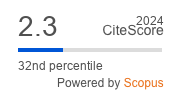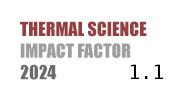THERMAL SCIENCE
International Scientific Journal
HYGROTHERMAL BEHAVIOR AT THE JUNCTION OF CEMENT MORTAR AND BIOBASED MATERIALS: FINITE ELEMENT STUDY OF HEMPCRETE, DATE PALM CONCRETE, AND CLAY BRICK
ABSTRACT
This study investigates the hygrothermal behavior at the junction between cement mortar and three biobased materials, hempcrete, date palm concrete, and clay brick, using the finite element method. Numerical simulations were conducted under both summer and winter conditions to analyze temperature and relative humidity distributions across a multilayer block at a depth of 145 mm. The results reveal that each material exhibits a distinct hygrothermal signature. Hempcrete ensures stable moisture buffering and smooth gradient transitions. Date palm concrete offers high moisture transfer and insulation performance, but with sharper discontinuities. Clay brick shows intermediate behavior with moderate buffering and more gradual junction transitions. The finite element method results highlight the junction as a critical zone where mismatches in material properties can lead to moisture accumulation, mechanical stresses, and durability concerns. These findings underscore the importance of selecting compatible materials and designing junctions carefully to ensure long-term performance and comfort in biobased building envelopes.
KEYWORDS
PAPER SUBMITTED: 2025-04-22
PAPER REVISED: 2025-06-29
PAPER ACCEPTED: 2025-07-30
PUBLISHED ONLINE: 2025-09-26
THERMAL SCIENCE YEAR
2025, VOLUME
29, ISSUE
Issue 4, PAGES [3239 - 3251]
- Paiva, R. D. L. M., et al., Influence of Bioaggregates on the Physical and Hygrothermal Properties of Bioconcretes, Construction and Building Materials, 456 (2024), 139218
- Belloum, R., et al., Hygrothermal Performance Assessment of a Biobased Building Made with Date Palm Concrete Walls, Building and Environment, 223 (2022), 109467
- Wu, D., et al., Simulation of the Hygrothermal Behavior of a Building Envelope Based on Phase Change Materials and a Biobased Concrete, Fluid Dynamics and Materials Processing, 18 (2022), 5, pp. 1483-1494
- Wu, D., et al., Multilayer Assembly of Phase Change Material and Biobased Concrete: A Passive Envelope to Improve the Energy and Hygrothermal Performance of Buildings, Energy Conversion and Management, 257 (2022), 115454
- Benkhaled, M., et al., Sensitivity Analysis of the Parameters for Assessing a Hygrothermal Transfer Model Ham in Biobased Hemp Concrete Material, International Communications in Heat and Mass Transfer, 132 (2022), 105884
- Ferroukhi, M. Y., et al., Impact of Microencapsulated Phase Change Material on a Biobased Building Composite, Hygrothermal and Mechanical Behavior, Construction and Building Materials, 409 (2023), 133925
- Affan, H., et al., Comparative Analysis of Biobased Insulation Materials with Low-Carbon Binders: Mechanical, Hygrothermal, and Durability Performance, Case Studies in Construction Materials, 22 (2025), e04915
- Benmahiddine, F., et al., Multi-Scale Analysis of the Effects of Hysteresis on the Hydrothermal Behaviour of Biobased Materials: Application Hemp Concrete, Construction and Building Materials, 411 (2024), 134107
- Ayati, B., et al., Mechanical and Hygrothermal Properties of Hemp-Silica Biocomposites, Construction and Building Materials, 425 (2024), 136077
- Aguiar, A. L., et al., Experimental Investigation on the Fire Performance of Wood Bioconcrete Using Cone Calorimeter, Fire Safety Journal, 148 (2024), 104225
- Wu, D., et al., Dynamic Hygrothermal Behavior and Energy Performance Analysis of a Novel Multilayer Building Envelope Based on PCM and Hemp Concrete, Construction and Building Materials, 341 (2022), 127739
- Charai, M., et al., Hygrothermal, Mechanical and Durability Assessment of Vegetable Concrete Mixes Made with Alfa Fibers for Structural and Thermal Insulating Applications, Construction and Building Materials, 335 (2022), 127518
- Bennai, F., et al., Assessment of Hygrothermal Performance of Hemp Concrete Compared to Conventional Building Materials at Overall Building Scale, Construction and Building Materials, 316 (2022), 126007
- El Moussi, Y., et al., Experimental Investigation on the Influence of Rice Straw Characteristics on the Hygric, Thermal and Mechanical Properties of Straw-Lime Concretes, Construction and Building Materials, 478 (2025), 141379
- Chennouf, N., et al., Hygrothermal Characterization of a New Biobased Construction Material: Concrete Reinforced with Date Palm Fibers, Construction and Building Materials, 192 (2018), Dec., pp. 348-356
- Ansari, H., et al., A Comprehensive Review on the Properties of Hemp Incorporated Concrete: An Approach to Low Carbon Footprint Construction, Next Sustainability, 5 (2025), 100075
- Ahmad, M. R., Chen, B., Influence of Type of Binder and Size of Plant Aggregate on the Hygrothermal Properties of Bioconcrete, Construction and Building Materials, 251 (2020), 118981
- Sawadogo, M., et al., Investigation of a Novel Biobased Phase Change Material Hemp Concrete for Passive Energy Storage in Buildings, Applied Thermal Engineering, 212 (2022), 118620
- Ntimugura, F., et al., Strength and Hygrothermal Performance of Low Carbon Insulation Materials Made of Lime Ternary Binders and Miscanthus Particles: Miscrete, Construction and Building Materials, 473 (2025), 141055
- Alioua, T., et al., Sensitivity Analysis of Transient Heat and Moisture Transfer in a Biobased Date Palm Concrete Wall, Building and Environment, 202 (2021), 108019
- Pietrak, K., et al., Magnesium-Hemp Concrete Is Less Vapor-Permeable Than Lime-Hemp Concrete While the Cup Method Is Still Problematic, Building and Environment, 280 (2025), 113112
- Benmahiddine, F., et al., Experimental investigation on the Influence of Immersion/Drying Cycles on the Hygrothermal and Mechanical Properties of Hemp Concrete, Journal of Building Engineering, 32 (2020), 101758
- Lagouin, M., et al., Influence of Types of Binder and Plant Aggregates on Hygrothermal and Mechanical Properties of Vegetal Concretes, Construction and Building Materials, 222 (2019), Oct., pp. 852-871
- Zou, Y., et al., A Dynamic Hysteresis Model of Heat and Mass Transfer for Hygrothermal Biobased Materials, Journal of Building Engineering, 79 (2023), 107910
- Benmahiddine, F., et al., Effect of Flax Shives Content and Size on the Hygrothermal and Mechanical Properties of Flax Concrete, Construction and Building Materials, 262 (2020), 120077
- Ramirez, R., et al., Hygro-Thermo-Mechanical Analysis of Brick Masonry Walls Subjected to Environmental Actions, Applied Sciences, 13 (2023), 7, 4514
- Feng, C., Janssen, H., Hygric Properties of Porous Building Materials (II): Analysis of Temperature Influence, Building and Environment, 99 (2016), Apr., pp. 107-118
- Schirmer, R., Die Diffusionszahl von Wasserdampf-Luft-Gemischen und die Verdampfungsgeschwindigkeit, Ph. D. thesis, VDI-Verlag, Dusseldorf, Germany, 1938
- Murray, F. W., On the Computation of Saturation Vapor Pressure, Journal of Applied Meteorology and Climatology, 6 (1966), 1, pp. 203-204
- Monteith, J. L., Shatleworth, M. H., Principles of Environmental Physics, 4th ed., Elsevier Ltd., London, UK, 2013
- Gummerson, R. J., et al., Water Movement in Porous Building Materials - II. Hydraulic Suction and Sorptivity of Brick and Other Masonry Materials, Building and Environment, 15 (1980), 2, pp. 101-108
- Cammerer, W. F., Wärme- Und Kälteschutz Im Bauwesen Und in Der Industrie, 5th ed., Springer, Berlin/Heidelberg, Germany, 1995
- Castellazzi, G., et al., Modelling of Non-Isothermal Salt Transport and Crystallization in Historic Masonry, Key Engineering Materials, 624 (2014), Sept., pp. 222-229
- Kunzel, H. M., Simultaneous Heat and Moisture Transport in Building Components: One- and 2-D Calculation Using Simple Parameters. Ph. D. thesis, Fraunhofer Institute for Building Physics, Stuttgart, Germany, 1995
- Bergman, T. L., Lavine, A. S., Fundamentals of Heat and Mass Transfer, 8th ed., John Wiley & Sons, Hoboken, N. J., USA, 2017
- Alioua, T., et al., Investigation on Heat And Moisture Transfer in Biobased Building Wall with Consideration of the Hysteresis Effect, Building and Environment, 163 (2019), 106333
- Seng, B., Etude expérimentale et numérique du comportement hygrothermique de blocs préfabriqués en béton de chanvre, Ph. D. thesisi, University Toulouse 3 Paul Sabatier (UT3 Paul Sabatier), Toulouse, France, 2018
- Ramirez, R., et al., Experimental Characterization of Moisture Transport in Brick Masonry with Natural Hydraulic Lime Mortar, Building and Environment, 205 (2021), 108256
- D'Altri, A. M., et al., A 3-D Detailed Micro-Model for the in-Plane and Out-of-Plane Numerical Analysis of Masonry Panels, Computers & Structures, 206 (2018), Aug., pp. 18-30
- Ghiassi, B., et al., Numerical study of the role of mortar joints in the bond behavior of FRP-strengthened masonry. Composites Part B: Engineering, 46 (2013), Mar., pp. 21-30
- Hagentoft, C. E., et al., Assessment Method of Numerical Prediction Models for Combined Heat, Air and Moisture Transfer in Building Components: Benchmarks for 1-D cases, Journal of Thermal Envelope and Building Science, 27 (2004), 4, pp. 327-352
- Fezzioui, N., et al., Numerical Study on Coupled Heat and Mass Transfer in Masonry Wall, Proceedings, 12th International Conference on Fluid-Flow, Heat and Mass Transfer (FFHMT 2025), Imperial College London Conference, London, UK, 2025

